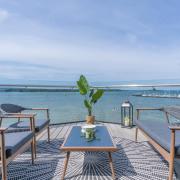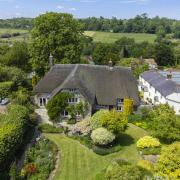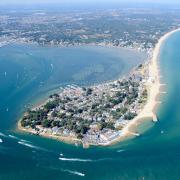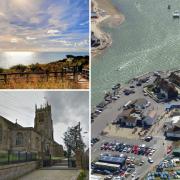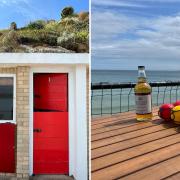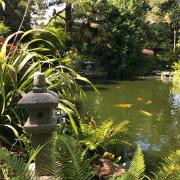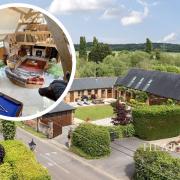Tucked away in a wood near Wareham, Careys Secret Garden is gently coming back to life thanks to its new owners who are combining regeneration with education
When Simon Constantine and his children stumbled upon ivy-clad brick walls and a padlocked wooden gate within the grounds of his parents’ new home, the Grade II listed Careys House near Wareham, they were more than a little surprised. Especially as there was no mention of them in the sales brochure. Intrigued, they pushed aside the gate’s wooden slats and, to their amazement, found a secret garden – now known as Careys Secret Garden.


Built in 1883, the walled garden was originally used for growing fruits and vegetables for the main house, and as a place for recreation. Years later, there are local stories of it being used as a place to graze farm animals, but, by the 1970s, cows and pigs had given way to nature which happily reclaimed it. Unlike most walled gardens, Careys has only three walls. This is a testament to its unique location, as its un-walled southerly aspect allows cold mists and frosts to flow out of the garden to the water meadows below, leaving delicate plants intact.
Simon’s chance discovery changed his life forever. After nearly 20 years, he stepped down as head of perfume and ethical purchasing at his parents’ company, Lush Cosmetics, whose HQ is in Poole, and threw himself into the restoration of this secret garden. His aspirations, however, went beyond a straightforward revamp. After years of travelling around the world, aiding communities with agroecology, permaculture, and ecological food production, an idea was growing. What if he could bring some of what he’d learnt back to his home county of Dorset?

I’m visiting Careys on a warm summer’s day in July. As I chat to Simon in the rose garden, we’re surrounded by the firework seed heads of allium and the delicious smell of lavender and roses. Holding the mesh headdress and long gloves of a beekeeper, Simon is dressed from head to toe in white. Unsurprisingly, he’s learning how to keep bees, and there are several hives scattered throughout the gardens.
Despite its long neglect, Simon and his dedicated team are gradually restoring the garden to its 19th-century grandeur, adding a few 21st-century twists along the way. ‘Our first year of design and landscaping went from the wettest winter on record, straight into a global pandemic,’ Simon recalls. ‘We first broke ground in the autumn of 2019, and every step had huge challenges to overcome.’

Their hard work was rewarded with several accolades, even at this early stage, including a Gold for New Tourism Business of the Year 2022 in the Dorset Tourism Awards.
Simon’s ideas for these award-winning gardens extend way beyond simply bringing plants and structure back to the plot. ‘I thought the best way to have an impact was through community demonstration - showing people how to adopt nature-friendly techniques in their gardens and in their fields and adapt to a changing climate.’

His passion for nature and education are apparent everywhere. Visitors to Careys can already take part in a variety of activities, from willow basket making and forest bathing, to outdoor yoga classes and wild food foraging walks. Future plans include extending their nature-inspired activities for children and developing the educational and permaculture aspect of the garden through online and on-site events.
As bees bumble past, my eye is caught by a nearby water feature crafted by local artist Ted Edley of Dorset Copperfish; its distinctive bath bomb shape is a subtle nod to the garden's Lush connection. Simon’s mum Mo Constantine created the first ever bath bomb in her Dorset shed back in 1989.

Gradually, this three-acre site is transforming into an eco-horticultural playground complete with reclaimed barn and outdoor kitchen for workshops. Where weeds once grew, there are now productive vegetable patches, newly planted fruit trees such as apricot and peach are espaliered against the 150-year-old brick wall absorbing its warmth, there are also greenhouses and a fruit cage. Drought-tolerant plants such as lavender, salvia, rosemary, and thyme grow in the Arid Garden as well as the Herb and Tea Garden. While, in a wilder part of the plot, there’s a food forest, stumpery, wild meadow, orchard, and nature-based play area for little wildlings.
‘The underlying term for what we are doing at Careys is regeneration.’ Simon explains. ‘A movement that allows us all to explore ways to heal the land and our communities, and we partner with those who pride themselves on doing the same.’

This is reflected in their partnerships with local companies, such as The Salt Pig in Wareham, who provide locally sourced food and drink for their onsite cafe The Secret Salt Pig, situated in the former potato store. And their course providers, such as Birds of Poole Harbour, not only share a commitment to the environment but are also experts at making their subject come alive.
Guided by my nose, I soon discover Simon’s on-site perfume outlet, ånd Fragrance. A tiny shop, tucked away in a beautifully restored curved potting shed attached to the garden wall. Simon’s wife, Vicky, encourages me to try Frank, a scent made from frankincense. To my surprise, it smells fruity and fresh rather than musty and old-fashioned. All of their fragrances are handmade, sustainable, vegan, and ethically sourced; it’s obvious that Simon’s lifelong love affair with perfumes still burns strong (andfragrance.com).

The gentle transformation of a wild overgrown plot to Careys Secret Garden is very much a team effort, and it’s clear that everyone involved is enjoying this journey. From Tink (aka Emma) and Katie who, with their infectious smiles ensure everyone has a great experience as soon as they walk through the gate, to Paul (head gardener) and Dan (garden planner) from Beeutiful Gardens with their limitless horticultural knowledge which they are always happy to share with visitors.
Paul and Dan first visited Careys after planting pollinator-friendly and aromatic plants in Simon’s own garden. ‘When we first opened the gates to Careys, their jaws dropped.’ Simon smiles. ‘From then on, they have been instrumental in bringing the right people and the right plants into the gardens to grow it to where it is now.’ It’s not only plants that have been nurtured and grown, as Paul and Dan also lead a team of enthusiastic volunteers and two gardening apprentices.

As I wander around this Purbeck plot, I sneak a peek into one of the two greenhouses and marvel at the colossal tomatoes nearly ripe for picking. In the wildflower meadow, I sit quietly on a bench, listening to a robin singing from the top of the wall as brown argus butterflies flit from flower to flower. Within minutes this idyllic place has worked its magic, my breathing has slowed, and my shoulders have relaxed from their usual position, way up by my ears.
By limiting the opening times and number of visitors (you must pre-book your ticket online), the team has skillfully maintained the mystique, tranquility and nature of the site, which is reached via a winding woodland path. It’s obvious from the moment you step through a gate in the wall, that this extraordinary restoration is a true labour of love. The team’s passion is palpable in every aspect of the garden.

It’s a welcoming place for anyone who wants to learn a new skill or simply have some time to contemplate life. As someone who works full-time and is also an unpaid carer, I found a sense of quiet positivity and calm that’s often missing from other more touristy places.
‘We have to avoid both a climate and ecosystem catastrophe,’ says Simon, when we catch up later after his bee-keeper training session. ‘So, the more of these spaces there are for people to come together, be inspired and to learn, the better.’
I love Simon’s passion for this garden and what he believes it can achieve. It’s infectious. I’ll be stepping through the gates at Careys Secret Garden again soon to learn more about the plants, or while away an hour or two in the wildflower meadow. I confess that I am tempted to keep this hidden gem a secret, though. It’s far too good to share!

What’s on at Careys this Summer
May 28: Open Day for the National Garden Scheme (10.30am - 3.30pm/ngs.org.uk)
May to September: Secret Yoga Flow every Saturday, multiple sessions.
July to November: Kiln Fired Clay Workshops. Themes include making an owl, tealight houses, botanical tiles, pitch pot plant holders and festive tealight holders.
July, September and November: Willow Basket Making Workshops.
Workshops & Walks: Introduction to Forest Bathing (June 10); Silver Clay Leaf Jewellery Workshop (June 16); Wild Food Foraging Walk (June 24): Nature Inspired Illustration Art Workshop (July 21)
Let’s go!
Open Thursdays, Fridays & Saturdays 10am – 4pm. Limited numbers, prebooking essential at careyssecretgarden.co.uk. The garden is a short walk along an undulating gravel track. Stout footwear is required. Disabled parking on-site, but this is a short walk to the garden’s entrance. Some plants are available to buy. All purchases by card only, including in the cafe. No dogs, other than registered assistance dogs.
Free Garden Tours: Approximately 11/2hours every Friday at 11am.
Cost: Adults: £7.50 Children under 12: £2.75. Free for under 5s. For an extra £2.50, visit the Berlin Wall exhibit, seven full-sized (4m high) pieces of the Wall installed in a corner of Careys’ peaceful woodland.
Meet the writer: Fascinated by all wildlife and wild places, Jane V Adams has called Dorset home for the last 20 years (janevadams.com). She writes about nature, gardening, travel and wellbeing and is author of Nature's Wonders: Moments that Mark the Seasons published by HarperCollins/National Trust. Jane is talking about her book at Sturminster Newton Literary Festival on June 10 (sturlitfest.com).
SUGGESTED PQS
‘The underlying term for what we are doing at Careys is regeneration’
'The more of these spaces there are for people to come together, be inspired and to learn, the better’
'Careys un-walled southerly aspect allows cold mists and frosts to flow out of the garden to the water meadows below'
'Its distinctive bath bomb shape is a subtle nod to the garden's Lush connection'




